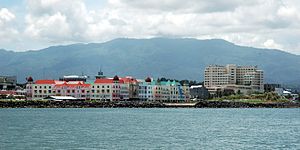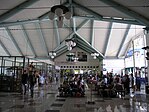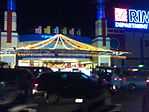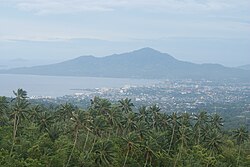Manado
Manado | |
|---|---|
| City of Manado Kota Manado | |
      Clockwise, from top, left to right: The city's seafront skyline, Bunaken National Park, Kalasey Beach, main terminal of Sam Ratulangi International Airport, Manado Town Square, and Soekarno Bridge | |
 Coat of arms | |
| Nickname(s): Kota 1001 Gereja (City of 1001 Churches) | |
| Motto(s): | |
 Location within North Sulawesi | |
 Manado Location in Downtown Manado, Sulawesi, and Southeast Asia | |
| Coordinates: 1°29′35″N 124°50′28.54″E / 1.49306°N 124.8412611°ECoordinates: 1°29′35″N 124°50′28.54″E / 1.49306°N 124.8412611°E | |
| Country | Indonesia |
| Province | North Sulawesi |
| Founded | 14 July 1623 |
| Government | |
| • Mayor | |
| • Vice Mayor | |
| Area | |
| • Total | 162.53 km2 (62.75 sq mi) |
| Elevation | 5 m (16 ft) |
| Population (2020 Census)[2] | |
| • Total | 451,916 |
| • Density | 2,800/km2 (7,200/sq mi) |
| Time zone | UTC+8 (ICST) |
| Area code | +62 431 |
| Vehicle registration | DB |
| Website | ManadoKota.go.id |
Manado (Indonesian pronunciation: [maˈnado]) is the capital city of the Indonesian province of North Sulawesi. It is the second largest city in Sulawesi after Makassar, with the 2020 Census giving a population of 451,916 distributed over a land area of 162.53 km2.[3] The Manado metropolitan area has a population of 1.2 million as of 2018.[4] The city is located adjacent to the Bay of Manado, and is surrounded by a mountainous area.[5]
Manado is among Indonesia's top-five tourism priorities.[6] The city is served by Sam Ratulangi International Airport, which has direct international flights to the Philippines, Singapore, and China, as well as many domestic destinations.[7] Bunaken National Park is one of the city's most famous tourist attractions. The city is also known for its Christian-majority population, and holds the country's biggest Christmas celebration annually.[8] It is also recognised as one of the most tolerant and peaceful cities in Indonesia.[9]
Etymology[]
The name Manado is derived from the Sangir language word manaro, meaning 'on the far coast' or 'in the distance', and originally referred to the further of two islands which can be seen from the mainland. When the settlement on this island was relocated to the mainland, the name Manado was brought with it, after which the island itself became referred to as Manado Tua (Old Manado).[10] The name for Manado in the Sangir language is Manaro.
History[]
The first mention of Manado comes from a world map by French cartographer , which shows the island of Manarow (today's Manado Tua). Before Europeans arrived in North Sulawesi, the area was under the rule of the Sultan of Ternate, who exacted tribute and introduced Islam to its inhabitants. The Portuguese made the Sultan their vassal, ruling over the Minahasa people, and establishing a factory in .
Meanwhile, the Spanish had already set themselves up in the Philippines and Minahasa was used to plant coffee that came from South America because of its rich soil. Manado was further developed by Spain as a centre of commerce for the Chinese traders who traded the coffee in China. With the help of native allies, the Spanish took over the Portuguese fortress in Amurang in the 1550s, and Spanish settlers also established a fort at Manado so that eventually Spain controlled all of the Minahasa. It was in Manado where one of the first Indo-Eurasian (Mestizo) communities in the archipelago developed during the 16th century.[11] The first King of Manado (1630) named Muntu Untu was in fact the son of a Spanish Mestizo.[12]

Spain renounced its possessions in Minahasa by means of a treaty with the Portuguese in return for a payment of 350,000 ducats.[13] Minahasan natives made an alliance treaty with the Dutch, and expelled the last of the Portuguese from Manado a few years later.
The Dutch East India Company or Verenigde Oost Indische Compagnie (VOC) built a fortress in Manado named Fort Amsterdam in 1658. As with regions in eastern Indonesia, Manado has undergone Christianisation by Dutch missionaries, including Riedel and John Gottlieb Schwarz. The Dutch missionaries built the first Christian church in Manado called Oude Kerk (Old church), which still stands, and is now called Gereja Sentrum. HMS Dover captured Manado in June 1810. The Javanese prince Diponegoro was exiled to Manado by the Dutch government in 1830 for leading a war of rebellion against the Dutch. In 1859, the English biologist Alfred Wallace visited Manado and praised the town for its beauty.
In 1919, the Apostolic Prefecture of Celebes was established in the city. In 1961, it was promoted to the Diocese of Manado.
The Japanese captured Manado in the Battle of Manado in January 1942.[14] The city was heavily damaged by Allied bombing during World War II.
In 1958, the headquarters of the rebel movement Permesta was moved to Manado. When Permesta confronted the central government with demands for political, economic and regional reform, Jakarta responded by bombing the city in February 1958, and then invading in June 1958.
In 1962, the People's Representative Council declared Manado as the official capital city of North Sulawesi Province.
Geography[]
Manado has a tropical rainforest climate (Af) according to the Köppen climate classification, as there is no real dry season. The wettest month is January, with an average rainfall of 465 millimetres (18.3 in), while the driest is September with an average rainfall of 121 millimetres (4.8 in).[15] The abundance of rain seems to be influenced by the monsoon. As its location is near the equator, the temperature seems constant throughout the year. The hottest month is August with an average temperature of 26.6 °C (79.9 °F), while the coolest months are January and February with an average temperature of 25.4 °C (77.7 °F).[16] Unlike other cities in Indonesia, the temperature seems to be cooler.[weasel words]
| hideClimate data for Manado, North Sulawesi, Indonesia (1961-1990) | |||||||||||||
|---|---|---|---|---|---|---|---|---|---|---|---|---|---|
| Month | Jan | Feb | Mar | Apr | May | Jun | Jul | Aug | Sep | Oct | Nov | Dec | Year |
| Average high °C (°F) | 29.4 (84.9) |
29.5 (85.1) |
30.0 (86.0) |
31.4 (88.5) |
31.4 (88.5) |
31.2 (88.2) |
31.3 (88.3) |
32.0 (89.6) |
32.3 (90.1) |
31.7 (89.1) |
30.9 (87.6) |
30.1 (86.2) |
30.9 (87.6) |
| Daily mean °C (°F) | 25.4 (77.7) |
25.4 (77.7) |
25.7 (78.3) |
26.4 (79.5) |
26.4 (79.5) |
26.2 (79.2) |
26.1 (79.0) |
26.6 (79.9) |
26.4 (79.5) |
26.3 (79.3) |
26.3 (79.3) |
25.8 (78.4) |
26.1 (79.0) |
| Average low °C (°F) | 22.3 (72.1) |
22.2 (72.0) |
22.3 (72.1) |
22.4 (72.3) |
22.4 (72.3) |
22.3 (72.1) |
21.8 (71.2) |
21.9 (71.4) |
21.2 (70.2) |
21.8 (71.2) |
22.3 (72.1) |
22.5 (72.5) |
22.1 (71.8) |
| Average rainfall mm (inches) | 427 (16.8) |
361 (14.2) |
338 (13.3) |
266 (10.5) |
268 (10.6) |
277 (10.9) |
170 (6.7) |
121 (4.8) |
149 (5.9) |
256 (10.1) |
290 (11.4) |
365 (14.4) |
3,288 (129.6) |
| Mean monthly sunshine hours | 129 | 119 | 155 | 168 | 168 | 144 | 176 | 210 | 179 | 172 | 157 | 152 | 1,929 |
| Source: Deutscher Wetterdienst[15][17][18][16][19] | |||||||||||||
| Jan | Feb | Mar | Apr | May | Jun | Jul | Aug | Sep | Oct | Nov | Dec |
|---|---|---|---|---|---|---|---|---|---|---|---|
| 28 °C (82 °F) | 28 °C (82 °F) | 27 °C (81 °F) | 27 °C (81 °F) | 28 °C (82 °F) | 28 °C (82 °F) | 28 °C (82 °F) | 28 °C (82 °F) | 29 °C (84 °F) | 28 °C (82 °F) | 28 °C (82 °F) | 28 °C (82 °F) |
Administrative Districts[]


The city is divided into eleven districts (kecamatan). These are tabulated below with their areas and populations at the 2010 Census[21] and 2020 Census.[22] The new districts of Bunaken Kepulauan (Bunaken Islands) and Paal Dua were established in 2012. The table also includes the location of the district administrative centres.
| District (kecamatan) |
Area in km2 |
Population Census 2010[23] |
Population Census 2020[24] |
Admin centre |
| Malalayang | 17.96 | 54,959 | 61,890 | Malalayang Satu |
| Sario | 1.99 | 23,198 | 21,740 | Sario |
| Wanea | 8.47 | 56,962 | 59,760 | Wanea |
| Wenang | 3.47 | 32,796 | 32,600 | Tikala Kumaraka |
| Tikala | 6.69 | 69,734 | 30,170 | Tikala Baru |
| Paal Dua | 9.38 | (a) | 44,020 | Ranomuut |
| Mapanget | 53.58 | 53,194 | 63,280 | Paniki Bawah |
| Singkil | 4.87 | 46,721 | 52,730 | Singkil |
| Tuminting | 5.26 | 52,089 | 53,760 | Bitung Karang Ria |
| Bunaken | 32.00 | 20,828 | 25,670 | Molas |
| Bunaken Kepulauan | 18.88 | (b) | 6,300 | Bunaken |
| Totals | 162.53 | 410,481 | 451,916 |
Notes:
(a) the 2010 population of Paal Dua District is included in the figure for Tikala District, from which it was cut out in 2013.
(b) the 2010 population of Bunaken Kepulauan District is included in the figure for Bunaken District, from which it was cut out in 2013.
The boundaries of Manado city are as follows:
- North = North Minahasa Regency and Mantehage straits
- South = Minahasa Regency
- West =
- East = Minahasa Regency
Demographics[]
Ethnicity and languages[]

This section does not cite any sources. (September 2020) |
Currently, the majority of Manado city residents are from the Minahasa ethnic group, because Manado is located in Minahasan lands. The indigenous people of Manado are from the Tombulu people. The Tombulu language is spoken widely in several urban villages within Manado, for example: Wenang (Wenang / Mahawenang - kolintang), Tumumpa (down), Mahakeret (yelling), Tikala Ares (Walak Ares Tombulu, where the word 'ares' means punishable), Ranotana (ground water), Winangun (built), Wawonasa (wawoinasa - sharpened above), Pinaesaan (unity place), Pakowa (Tree of Treasure), Teling (fur / bamboo to make equipment), Titiwungen (excavated), Tuminting (from the word Ting-Ting: a bell, the inserted syllable -um- changing the noun to a verb, so Tuminting: ringing bell), Pondol (Edge), Wanea (from the word Wanua: meaning the country), etc. While the Malalayang area has residents mainly from the Bantik people, other indigenous groups in Manado today are from the Sangir, Gorontalo, Mongondow, Babontehu, Talaud, Tionudese, Siau, and Borgo peoples. There are also Arabian peranakan communities, mainly in the Kampung Arab area which is near Pasar '45 and has become a destination for religious tourism. Other ethnicities represented include Javanese, Chinese, Batak, Makassar, and Moluccans. A small Jewish community also exists.

Manado Malay is the main language spoken in Manado. It is a Malay-based creole. Some of the loan words in the Minahasan vernacular are derived from Dutch, Portuguese, and other foreign languages.
Religion[]
Protestant Christianity is the major religion in Manado, constituting around 76 percent of all residents, Islam comes second forming about 10 percent, Catholicism comes in third forming around 10 percent, and the rest follow Buddhism, Hindusim, and Confucianism, each coming in at less than 1 percent each, according to the 2020 national census.[25] In addition, about 20 Indonesian Jews live in Manado.[26]
Even so, heterogeneous, but the people of Manado really appreciate the attitude of tolerant, harmonious, open and dynamic life. Therefore, the city of Manado has a relatively conducive social environment, and is known as one of the most relatively safe cities in Indonesia. When Indonesia was vulnerable to political upheaval around 1999, and riots hit cities in Indonesia, Manado city was said to be relatively safe. This is shown through the slogan of the people of Manado: Torang samua basudara, which means We are all family. And also through the words of Dr. Sam Ratulangi: "Sitou, Timou, Tumou, Tou", which roughly translates to 'Man lives to educate others'.
Transportation[]
This section does not cite any sources. (September 2020) |
Sam Ratulangi International Airport of Manado is one of the main entry ports to Indonesia. In 2005, no fewer than 15,000 international passengers entered Indonesia via the city's airport, its connected to several Indonesian cities such as Jakarta, Surabaya, Makassar, and others. Other public transportation in Manado are:
- Trans Kawanua (bus)
- Perum DAMRI buses serving airport to Manado
- Bus serving Tomohon to Manado
Manado–Bitung Toll Road connects the city with Bitung. Terminal Malalayang, or Malalayang Bus Terminal serves as the main gateway for long-distance buses in Manado.
Main sights[]
Manado is home to some of the biggest and most influential churches in the province, with many of them located along the iconic Sam Ratulangi Street.[27]
Tourism[]

- Ban Hin Kiong Temple is the oldest temple in the city of Manado, which was established in 1819. It is also a popular tourism spot in the city, especially during the Chinese New Year celebration.
- Other places of interest include nearby Lake Tondano, Lake Linow,[28] Lokon Volcano, Klabat Volcano and Mahawu Volcano, Bukit Kasih (hill of love), and Watu Pinabetengan.
- Citraland, a wealthy suburb of Manado, is home to Asia's second tallest and the world's fourth tallest statue of Christ (Christ Blessing Statue), and perhaps the world's first statue in the flying posture.[29]
- Scuba diving and snorkelling are practised in the nearby Bunaken National Park, including the island of Bunaken.[30][31][32]
- Manado Boulevard Carnaval (MBC) is a fashion carnival annually every 16 July, aligned with Manado City Birthday.[33]
- Several shopping malls in the city are: Manado Town Square, Star Square, and Grand Kawanua City
Cuisine[]


This section does not cite any sources. (September 2020) |
Food typical of Manado include Tinutuan, which consists of various kinds of vegetables. Tinutuan is not mush, as so far people have said it as Manado porridge. In addition to Tinutuan, there is Cakalang Fufu, a smoked skipjack ('Katsuwonus pelamis'), roa fish (exocoetidae or torani; Parexocoetus brachypterus), Kawok which is food based from rat meat of forest / White (Maxomys hellwandii); Paniki (meat-based dishes bat; Pteropus pumilus) and RW (abbreviated of Rinte Wuuk) is local name of the dog meat, Swine pig (1 pig is burnt by rotating on the embers), usually served at parties, Babi Putar (made from pork mixed with manado spices and rolled burned in bamboo). There is also a typical drink from the area of Manado and its surroundings are saguer which is a kind of wine or palm wine derived from enau / aren tree (Arenga pinnata), which is then fermented. This saguer has an alcohol content, Cap Tikus (high alcoholic beverage with average 40% more ethyl alcohol content derived from saguer distillation process depends on technique in different villages in Minahasa).

Woku is a type of bumbu (spice mixture) found in Manado cuisine of North Sulawesi, Indonesia. It has rich aroma and spicy taste. Woku consist of ground spices paste; red ginger, turmeric, candlenut, and red chili pepper, mixed with chopped shallot, scallion, tomato, lemon or citrus leaf, and turmeric leaf, lemon basil leaf, and bruised lemongrass. Rub main ingredients (chicken or fish) with salt and lime juices, and marinate for 30 minutes. All spices are cooked in coconut oil until the aroma came up and mixed together with the main ingredients, water, and a pinch of salt, well until all cooked well.
Other typical food of Manado city which is also quite famous is Nasi Kuning which taste and its presentation is different from yellow rice in other area because it is spiked with abon of cakalang rica fish and presented in parcel using sugar palm leaves. In addition, there are also grilled fish roasted head. Dabu-dabu is a very popular typical of Manado sauce, made from a mixture of red chillies, cayenne pepper, sliced red onion, and freshly diced tomatoes, and finally given a mixture of soy sauce.
Sister cities[]
This section does not cite any sources. (September 2020) |
 Eindhoven, Netherlands
Eindhoven, Netherlands San Sebastian, Spain
San Sebastian, Spain Cebu, Philippines
Cebu, Philippines Zamboanga City, Philippines
Zamboanga City, Philippines Davao, Philippines
Davao, Philippines Bristol, United Kingdom
Bristol, United Kingdom Liverpool, United Kingdom
Liverpool, United Kingdom Koror, Palau
Koror, Palau Qingdao, China
Qingdao, China
Language[]
This section does not cite any sources. (September 2020) |
The local language spoken in Manado and the surrounding area is a creole of the Malay language called Manado Malay. It exhibits significant influence of Portuguese, Spanish and Dutch, for example:
- Chair in Indonesian is kursi, in the Minahasa it is called kadera (cadeira - Portuguese word for chair).
- Horse in Indonesian is kuda, a word of Sanskrit origin. In the town of Tomohon, a horse is called kafalio ('cavalo - Portuguese', "caballo - Spanish).
- But in Indonesian is tetapi, in Manado it is called mar (maar- Dutch word for but).
While there is not much known about the origin of ideogramatical Minahasa writing system, currently the orthography used for indigenous Minahasan languages closely matches that used for Indonesian.
Notable people[]
This section does not cite any sources. (September 2020) |
- Leading figures in Indonesian history
- Robert Wolter Mongisidi, Indonesian national hero
- Alexander Andries Maramis, Foreign Minister of Indonesia, Minister of Finance
- Lambertus Nicodemus Palar, Indonesian national hero, first Indonesian representative to the United Nations
- John Lie, Indonesian national hero
- Elias Daniel (Daan) Mogot, first director of the Tangerang Military Academy
- Arie Frederik Lasut, Indonesian national hero, co-founder of Indonesia's first Mining and Geological Service
- Gerungan Saul Samuel Jozias (Sam) Ratulangi, Indonesian national hero, member of the Preparatory Committee for Indonesian Independence, first governor of Sulawesi
- Pierre Andries Tendean, Indonesian revolutionary hero
- Maria Walanda Maramis, Indonesian national hero, pioneer of women's rights in Indonesia
- Marie Thomas, first Indonesian female physician, first Indonesian specialist in obstetrics and gynaecology
- Alexander Evert Kawilarang, Indonesian military commander, freedom fighter, commander of military strategy and tactics, founder of Indonesian Special Forces.
- Important figures in Manadonese history
- Jacob Frederick (Joop) Warouw, commander of TT-VII/Indonesia Timur, leader of Permesta movement
- Anna Adeline Warouw, second Indonesian female physician, specialist in otorhinolaryngology
- Herman Nicolas Ventje Sumual, leader of Permesta movement
- Bernard Wilhelm Lapian, Indonesian national hero, church leader, second governor of Sulawesi
- Other community figures
- Adolf Gustaaf Lembong, commander of 16th Division
- Gustaf Hendrik Mantik, commander of Military Territory, governor of North Sulawesi
- Herling Laoh, Indonesian Public Works and Transportation Minister
- Gustaaf Adolf Maengkom, Indonesian Justice Minister
- Freddy Jaques Inkiriwang, Minister of Industry
- Arnold Isaac Zacharias Mononutu, Indonesian Information Minister, first ambassador of Indonesia to China, rector of Hassanuddin University
- Reyn Altin Johannes Lumenta, President and CEO of Garuda Indonesia
- , Chief Director of in the Grasberg mine
- Rocky Gerung, philosopher
- Sonita Lontoh, Technocrat of internet of things, Executive at Siemens, Digital Grid, Silicon Valley, USA; founder of Silicon Valley Asia Technology Alliance; Chairman of IDF
- Thomas Lembong, Minister of Trade of Indonesia; Head of Indonesia's Investment Coordinating Board
- Sportspeople and actors
- Jolene Marie Cholock Rotinsulu, Indonesian Actress, Puteri Indonesia Lingkungan 2019 and Miss International 2019 pageant.
- Kezia Roslin Cikita Warouw, Puteri Indonesia 2016 and Top 13 and Miss Phoenix Smile at Miss Universe 2016 pageant.
- Kristania Virginia Besouw, Miss Indonesia 2006, contestant at Miss World 2006 pageant
- Lilyana Natsir, badminton player and gold medalist at 2016 Summer Olympics
- Setyana Mapasa, badminton player
- Revo Marty, Indonesian Singer
- Firman Utina, Indonesian national footballer
- Dougy Mandagi, vocalist from The Temper Trap
- Rima Melati, actress
- Marcellino Lefrandt, actor
- Fictor Gideon Roring, Indonesian Basketball League head coach for Garuda Bandung
- Julie Estelle, actress
- Mikha Tambayong, actress
- Angel Karamoy, singer and actress
- Nagita Slavina, actress
See also[]
References[]
- ^ Badan Pusat Statistik. Jakarta, 2013.
- ^ Badan Pusat Statistik, Jakarta, 2021.
- ^ Badan Pusat Statistik, Jakarta, 2021.
- ^ "Sulawesi Utara Dalam Angka 2019".
- ^ "In the shadows of volcanoes: Manado Bay and its harbour". Archived from the original on 10 January 2011. Retrieved 14 December 2010.
- ^ https://ekonomi.bisnis.com/read/20191121/12/1172878/kembangkan-5-destinasi-prioritas-jokowi-tekankan-soal-kebersihan
- ^ https://bisnis.tempo.co/read/1252709/ap-i-besok-garuda-indonesia-layani-rute-manado-davao-filipina/full&view=ok
- ^ Christian
- ^ https://news.detik.com/berita/d-3738987/wali-kota-kaget-manado-jadi-kota-paling-toleran-di-indonesia
- ^ Willem H. Makaliwe, 1981, A preliminary note on genealogy and intermarriage in the Minahasa regency, North Sulawesi Bijdragen tot de Taal-, Land- en Volkenkunde 137, p. 245
- ^ Wahr, C.R. Minahasa (history) Website
- ^ Wahr, C. R. Minahasa (history) Website
- ^ Milburn, William (1813). Oriental commerce: containing a geographical description of the principal places in the East Indies, China, and Japan, with their produce, manufactures, and trade. New York: Black, Parry & Co. pp. 406.
- ^ L, Klemen (1999–2000). "The Fall of Menado, January 1942". Forgotten Campaign: The Dutch East Indies Campaign 1941–1942.
- ^ Jump up to: a b "Station 97014". Federal Ministry of Transport and Digital Infrastructure. Retrieved 29 July 2017.[permanent dead link]
- ^ Jump up to: a b "Station 97014". Federal Ministry of Transport and Digital Infrastructure. Retrieved 29 July 2017.[permanent dead link]
- ^ "Station 97014". Federal Ministry of Transport and Digital Infrastructure. Archived from the original on 17 October 2017. Retrieved 29 July 2017.
- ^ "Station 97014". Federal Ministry of Transport and Digital Infrastructure. Retrieved 29 July 2017.[permanent dead link]
- ^ "Station 97014". Federal Ministry of Transport and Digital Infrastructure. Retrieved 29 July 2017.
- ^ "Klimatafel von Manado / Nord-Celebes (Sulawesi) / Indonesien" (PDF). Federal Ministry of Transport and Digital Infrastructure. Retrieved 8 June 2016.
- ^ Biro Pusat Statistik, Jakarta, 2011.
- ^ Badan Pusat Statistik, Jakarta, 2021.
- ^ Badan Pusat Statistik, Jakarta, 2011.
- ^ Badan Pusat Statistik, Jakarta, 2021.
- ^ "Data Sensus Penduduk 2020 untuk Sulawesi Utara".
- ^ https://www.timesofisrael.com/jews-live-in-the-shadows-in-muslim-majority-indonesia/
- ^ "Great Churches of Manado". Archived from the original on 10 January 2011. Retrieved 14 December 2010.
- ^ "The lakes of Sulut: Danau Tondano and Linow". Archived from the original on 12 August 2016. Retrieved 14 December 2010.
- ^ "Christ Blessing and the Waruga". Archived from the original on 10 January 2011. Retrieved 14 December 2010.
- ^ "Off to Bunaken". Archived from the original on 10 January 2011. Retrieved 14 December 2010.
- ^ "Livin' la vida Bunaken's way". Archived from the original on 10 January 2011. Retrieved 14 December 2010.
- ^ "Bunaken's blue, blue seas". Archived from the original on 10 January 2011. Retrieved 14 December 2010.
- ^ "Manado Boulevard Carnaval - Digelar Rutin". 18 July 2011. Archived from the original on 18 August 2011. Retrieved 19 July 2011.
- "Visitors Arrivals to Indonesia 2000–2005" (PDF). budpar.go.id. Ministry of Tourism and Culture Republic of Indonesia.[permanent dead link]
External links[]
| Wikimedia Commons has media related to Manado. |
 Manado travel guide from Wikivoyage
Manado travel guide from Wikivoyage- . New International Encyclopedia. 1905.
- Huge Waves Cause Flooding in Manado, Sulawesi, Indonesia - Jan. 17, 2021
- Manado
- Cities in Indonesia
- Populated coastal places in Indonesia
- Populated places in North Sulawesi
- Provincial capitals in Indonesia






